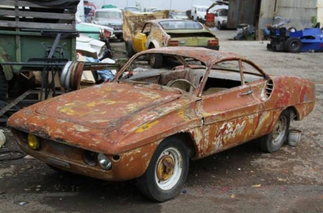Zaporozhets Sport 900: the Soviet sports car with the look of a German that has not passed
- COCKPIT

- Feb 27, 2023
- 3 min read

In 1963, an unusual sports car was presented in the USSR, the Zaporozhets Sport 900. This vehicle was created on the initiative of employees of the research and development institute of the automotive and motor industry NAMI.


In the early 1960s, a group of employees of the Central Scientific Research Institute of Automobile and Automotive Engines (NAMI institute) started a project to build a sports car for the masses. They had the support of Kuzma Durnov (the KD in the car's name) who was the director of the Moscow Auto Body Plant, although officially the car was named "Sport-900".

Initially, the team wanted to create a prototype, which after presentation to representatives of the authorities, it could go into serial production. To make work and further production as easy as possible, the vehicle was largely based on components from the ZAZ-965 and ZAZ-965A cars (modeled on the Fiat 600).

The car had a fiberglass body and used the air-cooled ZAZ 4cc V887 engine mounted in the tail. Development of the car continued throughout the 1960s, and 6 prototypes were built (with minor differences between them. So, the last "KD" received a roof of a redesigned shape - with a flat panel , not a dome panel and a wide rear rack (while retaining the frame configuration), plus a number of other differences in body trim, such as the design of the front panel and taillights The cars had a Coupe 2+2 layout, with the rear seats very small and uncomfortable.The KD900 turned out to be quite in the style of Western analogues of that time - Volkswagen Karmann Ghia or Renault Caravelle (Florida).

Under the hood, a slightly improved four-cylinder engine with a displacement of 887 cm³ and 23 hp, later increased to 27 hp placed in the rear. The weight of the car was only 500 kg, which is quite low for a car with length 3.7 m, which allowed a maximum speed of 120 km/h. The large size of the Zaporozhets engine in height forced the designers to give the body a pronounced wedge-shaped shape, with a low nose and a high rear, which was also advantageous from an aerodynamic point of view, reducing air resistance and reducing crosswind drift. Due to the limited possibilities, the interior was very poor and finished in a spartan manner.

Despite the qualities of the Sport-900, it did not arouse the interest and approval of the Soviet authorities. The Communists were not interested in producing cars that would appeal to Westerners, while the management of the ZAZ factory in Ukraine was in favor of its mass production.


The 6 prototypes produced passed into the hands of private owners with different fates.

The examples that have survived are all in a sorry state with mechanics that have been changed.
But some are awaiting restoration to return to their original state and thus save a piece of sports car history from the Soviet era and find a place in the museum.
In reality, its history is much more important than it seems, because this KD which became a turning point in the world of Samavto, because it allowed Ukrainian craftsmen of the time to be content to machine models imposed by the entity based in Moscow and to build models that they like and not "non-socialist" that did not exist in the USSR. Admittedly, the adventure did not allow it to go into mass production, but it was the first attempt in history and paved the way for other original designs.










Comments